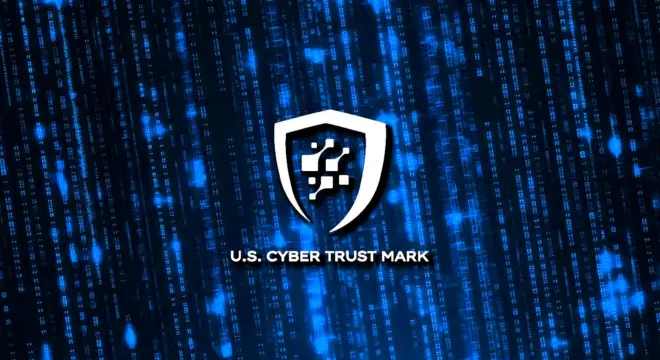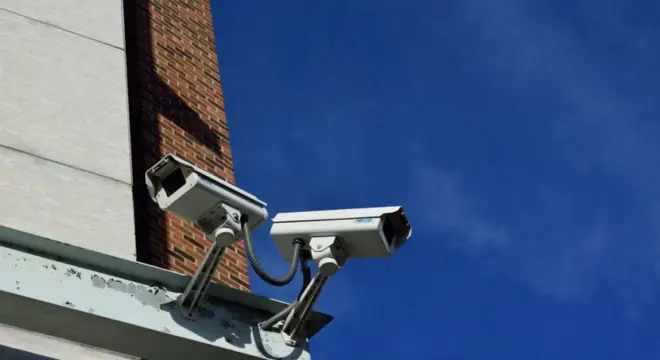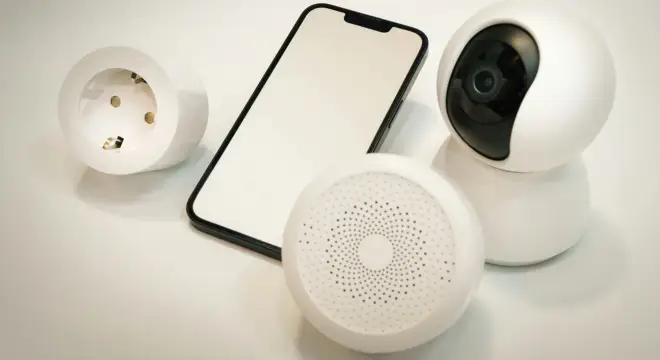Security Label: How the U.S. Cyber Trust Mark is Changing Smart Device Safety
Is your smart home truly secure?
Are your security cameras and smart devices at risk of being hacked?
Can a simple smart bulb expose your personal data?
In today’s digital world, smart home devices have become a part of everyday life—security cameras, smart locks, baby monitors, fitness trackers, and more. But while these devices offer comfort, they also come with serious cybersecurity risks. Hacked security cameras, data leaks, and the misuse of smart gadgets have become major concerns.
To address these growing threats, the U.S. government has launched the “Cyber Trust Mark” program—a special label awarded only to smart devices that meet high-security standards. This initiative aims to help consumers make safer choices, but is it enough to protect against cyber threats? Let’s dive deeper and find out.
Why Smart Device Security Matters: Real Cyber Attacks That Shocked the World
Imagine waking up one morning to find that some of the biggest websites—Twitter, Netflix, and Reddit—are suddenly down. You might think it’s a temporary glitch, but in reality, it was one of the biggest cyberattacks in history, powered by… smart home devices like security cameras and baby monitors!
1. Mirai Botnet Attack (2016):
In 2016, hackers launched a massive cyberattack by infecting millions of smart devices—security cameras, routers, DVRs—turning them into a powerful botnet army. This attack, known as the Mirai Botnet, caused major disruptions, proving that even the simplest smart gadgets can be hijacked to create global chaos.
Fast forward to 2024, and the threat hasn’t disappeared—it has only evolved.
2. Verkada Security Camera Breach (2024):
In 2024, hackers gained access to 150,000 Verkada security cameras, many of which were installed in hospitals, schools, psychiatric clinics, and even women’s health centers. This breach meant that cybercriminals could spy on patients, staff, and private spaces, raising serious concerns about privacy and security in smart devices.
These incidents highlight a crucial fact: If a device is connected to the internet, it can be hacked. This is exactly why the U.S. Cyber Trust Mark has been introduced—to help consumers identify secure devices and protect their homes from cyber threats. But is this enough? Let’s explore further.
What is the U.S. Cyber Trust Mark?
In today’s world, smart devices like security cameras, smart TVs, fitness trackers, baby monitors, and smart locks are everywhere. But the real question is: Are these devices secure?
To address this concern, the U.S. government has introduced the “Cyber Trust Mark” program. This is a special security label given only to smart devices that meet strict cybersecurity standards.
How Does It Work?
If a device receives the Cyber Trust Mark, it means it has passed the high-level security requirements set by the National Institute of Standards and Technology (NIST). Devices with this label must:
- Have strong & unique default passwords
- Provide regular software updates
- Implement data protection measures
- Detect hacking attempts and unauthorized access
This means that when you buy a Cyber Trust Mark-certified device, you get an extra layer of security, reducing the risk of hackers accessing your data.
Who Is Behind It?
- Federal Communications Commission (FCC) – Overseeing and implementing the program
- National Institute of Standards and Technology (NIST) – Defining cybersecurity standards
- The White House – Supporting the initiative
Which Devices Are Covered?
- Home security cameras
- Smart TVs
- Internet-connected appliances (e.g., smart refrigerators)
- Fitness trackers & wearables
- Climate control systems (smart thermostats)
- Baby monitors & smart locks
Which Devices Are NOT Included?
- Medical devices (regulated by the FDA)
- Cars & automotive equipment (regulated separately)
- Enterprise & industrial devices
- Wired devices (only wireless gadgets are covered)
- Computers, smartphones, and routers (not included yet but may be in the future)
How Does It Work?
The U.S. Cyber Trust Mark is not just a label—it represents a rigorous certification process that manufacturers must follow to prove their devices meet cybersecurity standards. Unlike marketing labels, this mark is backed by strict regulations and continuous monitoring.
Certification Process for Manufacturers
To earn the Cyber Trust Mark, manufacturers must go through a multi-step process:
1. Application and Initial Testing
- Manufacturers submit their smart devices for security evaluation.
- Devices are tested based on security criteria set by the National Institute of Standards and Technology (NIST).
2. Compliance with Key Security Standards
- Devices must have strong default passwords instead of common or easy-to-guess ones.
- They should support regular software updates to fix security vulnerabilities.
- Manufacturers must implement encryption and data protection to prevent unauthorized access.
- Devices should have intrusion detection mechanisms to identify hacking attempts.
3. Approval and Labeling
- If a device meets all security requirements, it is granted the Cyber Trust Mark certification.
- A QR code is placed alongside the mark, allowing consumers to check security details, including software update policies and the device’s minimum support period.

What Happens if a Company Falsely Claims Certification?
The certification is not optional once a company advertises its products as “Cyber Trust Mark-certified.” If a manufacturer falsely claims compliance:
- The Federal Communications Commission (FCC) can fine the company for deceptive labeling.
- The product may be recalled, preventing it from being sold.
- The company could face legal action for misleading consumers.
Strict penalties ensure that companies do not misuse the label for marketing purposes without actually meeting security requirements.
How Often Is Security Compliance Checked After Certification?
Cybersecurity is an ongoing process, so a one-time certification is not enough. After receiving the Cyber Trust Mark, companies must:
- Undergo periodic security audits to ensure continued compliance.
- Provide regular security updates to address new threats.
- Report security breaches and take corrective action if vulnerabilities are found.
If a device is later found to have major security flaws and the manufacturer fails to fix them, its Cyber Trust Mark certification can be revoked.
Comparison with Other Security Labels
Cybersecurity labeling is not a new concept—several countries have introduced their own standards to protect consumers from insecure smart devices. The U.S. Cyber Trust Mark is a step forward, but how does it compare with security labels in other regions, especially the EU’s Cybersecurity Label?
U.S. Cyber Trust Mark vs. EU’s Cybersecurity Label
| Feature | U.S. Cyber Trust Mark (USA) | EU Cybersecurity Label (Europe) |
| Regulating Body | FCC, NIST | ENISA (European Union Agency for Cybersecurity) |
| Focus Area | Consumer IoT Devices | Broad range of IoT and ICT (Information & Communication Technology) products |
| Security Standards | NIST-defined cybersecurity rules | Based on EU Cybersecurity Act and ETSI EN 303 645 standards |
| Compliance Process | Certification + periodic audits | Certification + self-assessment by manufacturers |
| Security Features | Strong passwords, software updates, data protection, intrusion detection | Strong passwords, encryption, vulnerability reporting, supply chain security |
| Label Type | Voluntary (companies opt-in) | Mandatory for certain critical devices |
| Consumer Transparency | QR code for detailed security info | Different levels of security certification based on risk |
Key Differences:
- Scope: The EU label covers a wider range of devices, including industrial IoT, while the U.S. Cyber Trust Mark focuses on consumer devices.
- Mandatory vs. Voluntary: The EU mandates security compliance for certain critical IoT products, whereas the U.S. label is voluntary for manufacturers.
- Supply Chain Security: The EU label focuses more on securing the entire supply chain, ensuring manufacturers follow cybersecurity best practices during production.
How Other Countries Handle IoT Security
Several other nations have introduced cybersecurity certification programs to improve IoT security.
1️. United Kingdom – IoT Security Law
- The UK Product Security and Telecommunications Infrastructure (PSTI) Act requires all smart devices to follow minimum security standards.
- Bans default passwords and requires security update policies to be clearly stated.
2️. Singapore – Cybersecurity Labelling Scheme (CLS)
- Four-level certification system (basic to advanced security).
- Higher certification levels require independent security testing.
- Recognized by Finland and Germany, allowing cross-border security compliance.
3️. Australia – IoT Code of Practice
- Not a formal label, but provides strict guidelines for manufacturers.
- Encourages strong authentication, encryption, and vulnerability disclosure.
Why This Comparison Matters
Understanding how different countries handle IoT security helps consumers make better choices. A global approach to cybersecurity labeling could improve international trade by ensuring that certified devices meet high security standards across different markets.
The U.S. Cyber Trust Mark is an important step, but can it evolve into a global standard? Future updates might need to align with EU and other international cybersecurity frameworks to create a stronger, unified security standard for all IoT devices.
What Are the Limitations of the U.S. Cyber Trust Mark?
The U.S. Cyber Trust Mark is a big step toward improving IoT security, but it isn’t perfect. While it provides better security awareness, there are several limitations that consumers and manufacturers should be aware of.
1️. Not All Devices Are Covered
Despite its importance, many smart devices are excluded from the Cyber Trust Mark program. Some of the major exclusions include:
- Medical Devices – These are regulated by the FDA (Food and Drug Administration), so they are not part of this program. However, medical IoT devices like wireless pacemakers and insulin pumps remain at risk.
- Cars & Automotive Technology – The National Highway Traffic Safety Administration (NHTSA) handles car cybersecurity. Given the rise of connected vehicles, not including them is a major gap.
- Traditional Wired Devices – The Cyber Trust Mark only applies to wireless IoT devices, meaning many smart home security systems with wired components may not be covered.
- Personal Computers & Smartphones – Surprisingly, laptops, smartphones, and routers are not included in the program (at least for now). These are some of the most targeted devices by hackers, yet they remain outside the Cyber Trust Mark’s scope.
2️. Challenges for Small Manufacturers
While big companies like Amazon, Google, and Samsung have the resources to meet cybersecurity standards, smaller IoT manufacturers may struggle with compliance.
- Certification Costs – Getting certified under the U.S. Cyber Trust Mark requires rigorous security testing, which can be expensive for startups and smaller businesses.
- Ongoing Compliance – Even after certification, companies must maintain security standards through regular updates. Smaller companies with limited IT security teams may find this difficult.
- Slow Adoption – If only big brands participate in the program, cheaper, uncertified alternatives may flood the market, leaving consumers exposed to cybersecurity risks.
3️. Concerns About Enforcement & Penalties
Even though the Cyber Trust Mark is meant to protect consumers, there are concerns about how effectively it will be enforced.
- Fake or Misleading Certifications – What happens if a company falsely claims certification without meeting security standards? Who will audit and verify ongoing compliance?
- Security Updates & Lifespan – Some smart devices stop receiving updates after a few years. Will companies be forced to provide long-term support for certified products?
- No Clear Penalties – If a certified device is later found to have security flaws, what action will be taken against the manufacturer? Will there be fines, recalls, or other penalties? These questions remain unclear.
The Future of Smart Device Security
The U.S. Cyber Trust Mark is just the beginning of a new era in cybersecurity. As smart devices become more integrated into our daily lives, the way we secure them must evolve too. But what’s next? Could this program become mandatory? How will AI and machine learning shape the future of smart home security? Let’s take a look at what the future might hold.
1️. Could the Cyber Trust Mark Become Mandatory?
Right now, the U.S. Cyber Trust Mark is voluntary, meaning manufacturers can choose whether they want to apply for certification. But will this change in the future?
- Consumer Demand for Security – As cyberattacks become more common, people will demand stronger protection for their smart devices. If companies don’t voluntarily follow cybersecurity guidelines, government regulations might make it mandatory.
- Government Action – The EU’s cybersecurity label already has mandatory elements, especially for critical devices. The U.S. could follow a similar path in the coming years.
- Impact on Insurance & Retailers – Some insurance companies might start offering discounts to homes that only use certified smart devices. Retailers like Amazon & Best Buy could eventually prioritize or even require the label for smart home products.
If the Cyber Trust Mark becomes mandatory, it could force all manufacturers—big and small—to meet strong security standards, making smart homes safer.
2️. AI & Machine Learning: The Future of Smart Home Security
Cybersecurity isn’t just about strong passwords and software updates anymore. The next phase of smart device security will be driven by AI (Artificial Intelligence) and Machine Learning (ML).
(i). AI-Powered Intrusion Detection
Imagine a smart home system that automatically detects suspicious activity and blocks hacking attempts in real-time. AI can analyze network behavior and flag unusual access patterns.
(ii). Self-Healing Systems
Future IoT devices might be able to detect vulnerabilities and patch them automatically, reducing the need for manual updates.
(iii). AI-Assisted Privacy Protection
AI could help consumers configure their devices securely by giving personalized recommendations on settings and permissions.
As AI continues to evolve, it could help eliminate many cybersecurity risks before they even become a problem.
3️. Expansion to More Devices: What’s Next?
Right now, the Cyber Trust Mark focuses on consumer IoT devices like smart TVs, cameras, and appliances. But in the future, we could see it expand to even more critical technology.
(i). Smart Cars & Autonomous Vehicles
With cars becoming more connected, hacking threats are increasing. A security label for automotive IoT could protect drivers from cyberattacks that target navigation, braking, or even self-driving systems.
(ii). Personal Computers & Smartphones
Although they are not currently included, laptops, smartphones, and routers are prime targets for cybercriminals. Future cybersecurity labels could ensure stronger protection for these everyday devices.
(iii). Medical IoT & Wearables
From wireless pacemakers to smart insulin pumps, healthcare IoT devices need strong cybersecurity measures to prevent life-threatening cyberattacks.
If cybersecurity labels expand to more devices, it will help create a more secure digital ecosystem, protecting not just our homes, but also our vehicles, workplaces, and hospitals.
How Consumers Can Protect Themselves Today
While the U.S. Cyber Trust Mark is a great step toward better security, most smart devices still don’t have this certification. So, how can you protect yourself right now? Even if your devices aren’t certified, there are several steps you can take to secure them from hackers.
1️. What to Do If Your Device Is Not Certified?
If your smart device does not have the Cyber Trust Mark, don’t panic! You can still make it more secure by following these steps:
- Check for Security Updates – Many devices get firmware updates that fix security vulnerabilities. Always update your smart devices regularly.
- Change Default Passwords – Most devices come with weak default passwords (like “admin123”). Change them immediately to strong, unique passwords.
- Turn Off Unused Features – Features like remote access and voice assistants can be exploited. Disable anything you don’t need to reduce risk.
- Research Before Buying – If you’re buying a new smart device, choose brands that prioritize security. Look for companies that offer long-term software updates.
2️. Alternative Ways to Secure Your Smart Devices
Even without a Cyber Trust Mark, you can increase security using additional layers of protection.
(i). Use a VPN for Your Home Network
A VPN (Virtual Private Network) encrypts your internet traffic, making it harder for hackers to intercept your data. Some routers even have built-in VPN support.
(ii). Set Up Network Segmentation
Instead of connecting all devices to the same Wi-Fi, create a separate network for your smart devices.
- Main Wi-Fi: Use this for personal devices like phones and laptops.
- IoT Network: A separate network for smart TVs, cameras, and home assistants.
- This way, if a hacker compromises one device, they won’t get access to everything.
(iii). Enable Two-Factor Authentication (2FA)
If your smart device supports 2FA, enable it! This adds an extra security layer by requiring a verification code when logging in.
(iv). Monitor Your Network Activity
Use router logs or a security app to check for unusual activity. If a device is sending data at odd hours, it could be compromised.
Conclusion
The U.S. Cyber Trust Mark is a big step toward safer smart devices, but cybersecurity remains a shared responsibility. While certified devices offer more protection, users should still take basic security measures like strong passwords, VPNs, and regular updates.
Would you prefer certified devices, or do you think stricter regulations are needed?
Feel free to reach out to me!


